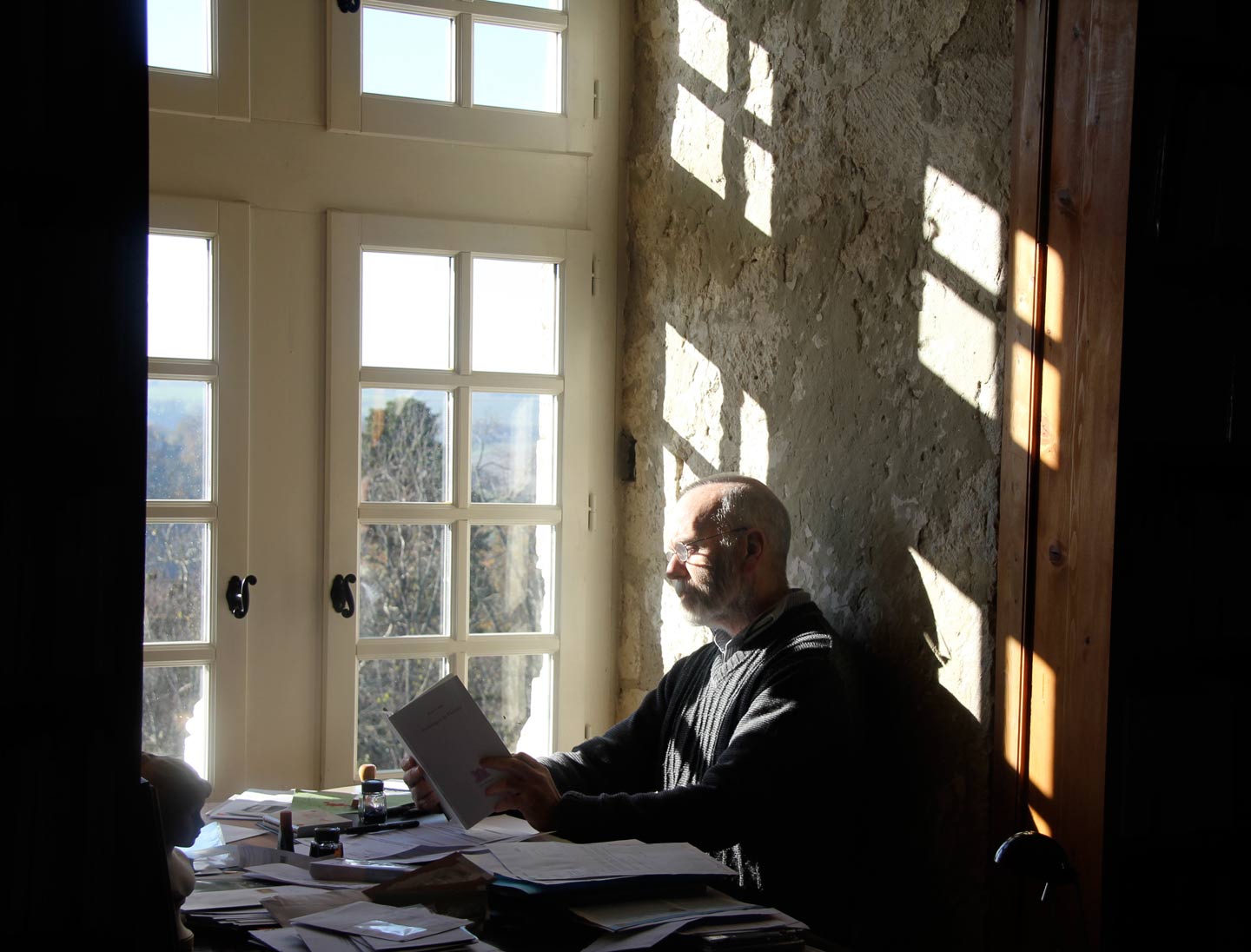A pioneering gay writer in the heady 1980s. A laureate of the Académie Française, a literary circle so rarefied that its members are known as les immortels. A radical champion of art for art’s sake who withdrew to a 14th-century château to live among the paintings and the pictures that were the only sources of meaning he ever seemed to recognize. These are all descriptions that might once have captured the essence of Renaud Camus.
His trademark was fearlessness, as evinced in his 1979 autobiographical novel, Tricks, which recounts in unsparing detail a string of nonchalant homosexual encounters the narrator has in nightclub bathrooms and grimy apartments on both sides of the Atlantic. “I put saliva in my ass, kneeled on both sides of him, and brought his penis, which was not of a very considerable size, inside me without much difficulty,” we read of one such encounter. “He came the moment one of my fingers was pressed inside the crack of his ass.” That was Camus then.
These days, the author of Tricks is better known as the principal architect of le grand remplacement (the great replacement), the conspiracy theory that white, Christian Europe is being invaded and destroyed by hordes of black and brown immigrants from North and sub-Saharan Africa. Since 2012, when it appeared as the title of a book Camus self-published, the term “great replacement” has become a rallying cry of white supremacists around the world—the demonstrators who stormed through Charlottesville, Virginia, in August 2017; the man who killed 11 worshippers at the Tree of Life synagogue in Pittsburgh in October 2018; and especially Brenton Tarrant, the suspect in the New Zealand mosque attacks in March. Tarrant posted his own “The Great Replacement”—a 74-page online manifesto—before murdering 51 people.
The day after the Christchurch shooting, I called Camus out of the blue, reporting for The Washington Post. He told me then that he condemned this kind of violence but that he ultimately appreciated the attention these episodes have brought to his arguments. Does he resent “the fact that people take notice of the ethnic substitution that is in progress in my country?” he asked rhetorically. “No. To the contrary.”
Camus, now 72, lives in Plieux, France, a peaceful afterthought of a town about an hour by car from the nearest train station. But when people are slaughtered in mosques in the antipodes, his phone starts to ring. Although he tweets constantly—even without the coveted blue check mark—public figures start to engage with him. And after a series of exchanges with French and foreign journalists, he has typically generated enough material for the online diary he publishes.
Popular
"swipe left below to view more authors"Swipe →
But he isn’t just a commentator. Camus was a candidate in May’s European Parliament elections. Although his party came in second to last—the Esperanto party won 10 times as many votes—his presence on the ticket was more than a stunt. He is a living symbol of a profound cultural shift in which Europe has abandoned its postwar creed of tolerance for identitarian anger. Days before the vote, a photograph emerged of a candidate on his ticket kneeling before a giant swastika. (Camus then withdrew from the election, assuring me that the swastika was “the opposite of everything I’ve fought for my whole life.”)
Camus is not the first person in France to feel that there are too many Muslims and too many migrants, nor has he refashioned this view in any particular way. What he does offer is a kind of cultivated spectacle, a performance of sorts: the outraged aesthete, stewing in an ancient stone chrysalis about the demographic decline of a society he deliberately avoids. If le grand remplacement is what Camus believes, it has also proved a surefire means of keeping himself in the papers when he might otherwise have been forgotten. One can think of Camus as a more successful version of Steve Bannon, whose designs in Europe have amounted to little more than a handful of appearances on television at the wrong times of day and an ostensible network of right-wing “schools” that are more accurately described as identitarian book clubs than as training grounds for the so-called populist elite Bannon vowed to create. Though Camus has announced no such grand ambitions, his impact has been much more profound. A forthcoming 2019 study conducted by the Institute of Strategic Dialogue, based on social-media analytics, depicts Camus as the top influencer on the subject of remigration, or the forced return of non-Europeans to their countries of origin. He ranked higher than Donald Trump.
Camus disputes the notion that he has undergone a transformation of any kind. “I think my life is united,” he told me recently. Tricks was an attempt to say what could not be said, and Le Grand Remplacement is the same. “Homosexuality could only be mentioned in an erotic context, and never in simple terms. Tricks is a paradoxical book that shows that what is told isn’t extraordinary, that there isn’t much to tell, in fact.” He sees himself as a truth teller, someone who merely records what should be clear for all to see. “The mission of the great writer in society is to go toward what is not said, the untold part of the discourse.”
Camus may be right in saying that he has been the same person throughout his writing life, but not necessarily in the way he thinks. What applies to each of his personas—edgy gay writer, avid Marine Le Pen supporter—is a particular embrace of, or at least aspiration toward, aestheticism. What seems to matter most is not whether something is true and not even whether something is good but whether something is beautiful, at least according to his definition. “The logical result of Fascism,” Walter Benjamin famously observed, “is the introduction of aesthetics into political life.”
Yet real taste eludes Camus; his self-presentation—a spotless three-piece suit the day I met him, a cavernous library strewn with books just so—is a little excessive. On his website, he gazes out onto empty fields in pensive profile like a living Rodin statue. What you see is an intellectual from central casting, a chatelain from a Netflix period piece. But the Kabuki is so stylized that what comes across is the artifice, not the essence. To interview Camus is to listen to the same lines he has already published and that he repeats constantly. “Racism turned Europe into a field of ruins. Anti-racism has turned it into a hyperviolent slum,” he told me. When he began to say it, I jotted the rest of it down before he even finished the sentence. We have seen this particular period piece before.
Aesthetics are the essence of le grand remplacement. For Camus, this is the defense of the beautiful society, the dogged and even violent pursuit of the pure. The problem, of course, is that le grand remplacement is not real: If demographic changes have been well-documented, the white utopia of his imagination has never existed in his lifetime. For the entirety of the 20th century, France has been home to one of the most ethnically diverse populations in Western Europe. Significant demographic changes occurred during decolonization in the 1960s and ’70s; the arrivals today are hardly unprecedented. Le Grand Remplacement purports to reveal the truth, but it is the lie, not “the untold part of the discourse.” As a matter of aesthetics, Le Grand Remplacement is kitsch, a dime-store distortion, a false image accessible to all that arouses base sensations—mostly pangs of nostalgia but also fits of rage. In the end, its tackiness is its strength.
It’s difficult to date the radicalization of Camus with any precision. But one crucial marker is l’affaire Camus, as it is still known, which saw him accused of anti-Semitism—allegations that ruined his then very considerable reputation and banished him from polite society forever. The shift in his public persona—from semirespected novelist to conspiracy theorist—entirely occurred after l’affaire. Le Grand Remplacement is many things, but most of all, it is the brainchild of a pariah, the scandalous rejoinder of a man who has nothing left to lose.
L’affaire began in April 2000, when Camus published La Campagne de France, an edition of his diary from 1994. In that book, he observed—with a sneer reminiscent of the diarists Jules and Edmond Goncourt, themselves no great admirers of Jews—that there were simply too many Jews on France Culture, the crown jewel of France’s national public radio. “They are roughly four out of five on every broadcast, or four out of six, or five out of seven, which on a national or almost official platform constitutes a net overrepresentation,” Camus complained.
The problem, he wrote, was not so much the number of Jews on France Culture as the fundamental impossibility for a Jew—even one whose family has been French for generations—to understand and explain French culture to a French audience. He lamented that “the French experience as it has been lived for 15 centuries by French people on the French soil” had “for its principal spokesman” members of “the Jewish race.”
Camus committed what in French cultural life is still the unforgivable sin: not just anti-Semitism but the kind of anti-Semitism that harks back to the invective of the 19th century, when proudly French Jews such as the military captain Alfred Dreyfus were condemned as foreigners and even as traitors. In much the same way, Camus, a man of letters himself, implied that iconic French writers such as Marcel Proust, who was half-Jewish, and Romain Gary, a Lithuanian Jewish immigrant, were only able to “explain this culture and this civilization in a way that to them is external.”
The French writer Marc Weitzmann, then a young journalist at Les Inrockuptibles, the bad-boy Parisian cultural weekly, was the first to hold Camus accountable. After he read the passages in La Campagne de France, he said, he invited Camus for a drink at Café Beaubourg, then as now a choice watering hole of Paris’s bon chic bon genre crowd. “That’s when I decided to write something, because the guy was so disgusting,” Weitzmann told me recently. “If he had just said, ‘I don’t like Jews’ and ‘Fuck you,’ that would have almost been fine, because at least that would have been coherent. But when I asked him, he told me that to write what pleased him did not make him anti-Semitic, and that the only word he regretted having written about the Jews was ‘race.’”
L’affaire was the beginning of the end: Friends stopped calling, the buzz surrounding his name was no longer positive, and reputable publishers started to drop him (these days he self-publishes). “It was a very unpleasant experience indeed,” he said. In his telling, he is the victim. “To me, it seemed to be the case,” he said of the observations he made. “I thought I could say it.” Nearly 20 years later, this is his summary of what happened: “Some people who don’t read, who know nothing about me, accused me of being anti-Semitic. Which is the most absurd thing in the world.” But the swastikas somehow follow him wherever he goes.
In a perverse way, Camus’s Le Grand Remplacement can be seen as a kind of atonement. One of his central arguments is that Muslims cannot be tolerated en masse because of the apparent threat they pose to Jews. This is a view that he expresses in crude, reductive statements—but that most of the French elite have by now completely accepted, especially since 12 Jews have been murdered in France over the past 15 years (in each case by at least one assailant of West African or North African descent). Well-heeled readers of Le Figaro, however, still prefer a euphemism for this phenomenon. They call it le nouvel antisémitisme (the new anti-Semitism), but everyone knows which perpetrators are implied.
And Camus now has a number of prominent Jewish defenders, most notably Alain Finkielkraut, a household name in France and a hard-line conservative thinker who has taken his side since 2000. “[Camus] was speaking about a show on France Culture, and while he expressed himself in terms that were certainly maladroit, the campaign against him was totally unjust,” Finkielkraut, who has since invited Camus back onto his own popular France Culture program, told me recently. Demographic substitution, Finkielkraut said, is “not a conspiracy theory.” But he sighed when asked about Camus’s politics today and his frequent talk of “genocide by substitution.”
“He testifies to the anxiety of French identity, but he is so radical in his propositions. He’s become totally inaudible.” Apart from Finkielkraut, there is the polemicist Éric Zemmour, who further propagated Camus’s grand remplacement in two recent books, Le Suicide Français (2014) and Destin Français (2018). Zemmour may be a provocateur, but he is also a shrewd businessman: Both books topped best-seller lists in France for weeks.
Performing philo-Semitism—or at least anti-anti-Semitism—has become something of an obsession for Camus. These days, he has been painting a series of canvases that depict the Hebrew letter aleph. Likewise, in his platform for the European Parliament elections, he wrote that the creed of tolerance preached by liberal elites “has inaugurated a world where the Holocaust becomes more and more difficult to teach and where Jews are obligated to flee by the thousands.”
At the same time, like many on the contemporary far right—Trump, Hungary’s Viktor Orbán, and even Israel’s Benjamin Netanyahu—Camus blames what he sees as a terrifying new world on a cabal whose character bears a striking resemblance to the old anti-Semitism of the Protocols of the Elders of Zion. “Let’s say the Davocracy,” Camus writes, “the managerial governance of the world by Davos, by technology and by finance, by the abstract manipulation of figures, words, souls, thoughts and men.” Another example: After Charlottesville, he took it upon himself to publish—in English—another book, titled You Will Not Replace Us! Only one thing about Charlottesville bothered him: “It was ‘Jews will not replace us!’ that horrified me,” he said.
Camus told me that what was most painful about his experience with anti-Semitism was that “things were very ambiguous.” He meant by this not only that people were uncertain as to his character but also that they did not understand what he actually said. These days, he has abandoned nuance. As he put it, “Today there is no ambiguity.”
In much of French fin de siècle literature the figure of the aesthete is an aloof but judgmental presence. This judgmental aspect is perhaps the aesthete’s most defining attribute, for what truly motivates a person to seek an alternative reality of unadulterated beauty is a profound sense of disgust with the world as it is. There is no better evocation of this particular psychology than the character of Jean des Esseintes, the antihero of Joris-Karl Huysmans’s À Rebours, most commonly translated as Against Nature, perhaps the greatest treatise on the aesthete ever written. “His contempt for humanity deepened. He reached the conclusion that the world, for the most part, was composed of scoundrels and imbeciles,” Huysmans writes of des Esseintes. “Already, he was dreaming of a refined solitude, a comfortable desert, a motionless ark in which to seek refuge from the unending deluge of human stupidity.” There is more than a little des Esseintes in Camus: Both have withdrawn into worlds of their own design, entirely because of shared contempt for social evolution.
The aesthete is a natural reactionary, and Camus is no exception. Perhaps the most important thing to understand about Le Grand Remplacement is that it is primarily an aesthetic critique. His inspiration, he said, came when he was commissioned to write a 1999 travel guide to the Hérault, a rocky, arid region of vineyards and olive groves that surrounds Montpellier on France’s western Mediterranean coast. While researching the book, he told me, he stumbled upon a cluster of veiled Muslim women outside an ancient stone church. They did not belong there, he said. “Of course, it’s related to my taste for architecture, for heritage. There was something that wasn’t right. As if in a film on Louis XIV’s Versailles, some armored knights from the Middle Ages appeared. [That] would be an anachronism. In this case it was anatopism, something [in the wrong place].”
In time, the image of these veiled women—about whom Camus said he could recall no concrete details—triggered in him a much broader anxiety. Le Grand Remplacement, he said, is not merely about the replacement of some people by others. It is also, he said, “the fact that everything is replaced by something else: the original by the copy, the authentic by the imitation, the object by its facsimile, writers by intellectuals, literature by journalism, journalism by information, information by fake news, Venice by Venice in Las Vegas, Las Vegas by Las Vegas in a Spanish desert or anywhere else.” But this is a logic that makes sense only if one accepts the premise that migrants and foreigners are somehow fake—ersatz copies of an authentic original they can neither understand nor interpret. “The fake is at the heart of global replacement,” he told me. “This is a world where everything is fake, where everything is the imitation of what things should be.”
If the aesthete is a natural reactionary, he is also a natural xenophobe. Concerns about decline and decay often metastasize into prosaic prejudice toward a chosen other. In the 19th century, Édouard Drumont, France’s most notorious anti-Semite, railed against Jews primarily because of the threat he believed they posed to the patrimoine, France’s cultural heritage. It is often forgotten that Drumont—long before he wrote La France Juive (1886), the anti-Semitic screed that would ensure his notoriety—was an antiquarian who decried the modernization of his beloved Paris. His first book, Mon Vieux Paris, is a nostalgic reverie for a city destroyed by corrupt railroad companies, department stores, and the grand boulevards of Baron Haussmann. “Our traditions, our faith, our heritage of beliefs and ideas: all this constitutes the soul of la Patrie, which I defend,” Drumont wrote. As he researched his book, he became more interested in who was responsible for this attack on the material landscape and the built environment of his cherished homeland. “A light went off in my spirit,” he would later write in an 1892 article. “I was struck by the terrible power of this race that had, in a matter of years, trampled on the race of the ancient French.” Camus has identified a different enemy, but in 2019 he does not sound significantly different.
Camus can also be seen as a contemporary addendum to the long tradition of fascist aesthetics: the veneration of violence, the glamorization of death, and most of all, the transformation of the human subject into an object to be arranged as needed, recast if possible, and discarded if necessary. In 1909, Filippo Tommaso Marinetti, the founder of the Futurist movement and an avid supporter of Benito Mussolini, articulated the first concrete definition of fascist aesthetics in reference to Italy’s Ethiopian conquests. Marinetti wrote, “We want to glorify war—the only cure for the world—militarism, patriotism, the destructive gesture of the anarchists, the beautiful ideas which kill, and contempt for women.” Beauty, for him, was derived from the sheer scale of the spectacle as much as from an epochal clash. What he yearned for was a choreography of chaos, a Brueghel canvas brought to life. Only in such a cacophony can the human body reach its full potential, destructive though it may be.
Camus dreams and even fantasizes about identical scenes. In You Will Not Replace Us! he describes the doomsday battle on which his entire project is based, the ultimate showdown in which “replacists”—his name for those who support immigration and cultural diversity—are finally attacked by the newcomers they have foolishly championed. His emphasis is sexual, and the variety of beauty he evokes is derived from the image of an idealized male body dominating a weaker, decadent cousin. “Replacists will be eaten, devored [sic], absorbed, replaced by their replacers même,” Camus writes. “Replacists replace lambs by wolfs. They replace docile replacees, well prepared to their own repalcemement [sic] by excess of comfort, too much civilization, too little culture and constant propaganda, by rather agressive [sic] replacers, younger, more numberous [sic], testeronically [sic] superior, well fed by their replacees and fiercely identitarian (especially the muslims [sic] amongst them). Replacists will be gobbled up first. That is a meager consolation.”
And yet there is an important difference between Camus and the masters of the fascist aesthetic—the filmmaker Leni Riefenstahl, the novelist Louis-Ferdinand Céline, the poet Ezra Pound. If each was a bigot and an avowed supporter of a fascist regime, each was also a genuine artist whose talent cannot be denied in the name of moral bankruptcy—an uncomfortable reality that challenges critics to this day. But Camus, aesthete though he may be, is no such artist, regardless of his pretensions. He lacks both the formal talent and the vision. He is far better understood as fascist kitsch than fascist avant-garde, guilty of the same defects he blames for the decline of Western civilization: “imitation, ersatz, simulacrum, copies, counterfeiting, fakes, forgeries, lures, mimics.” The embrace of kitsch was apparent even in one of his early novels, Roman Roi (1983), a Cold War portrait of a made-up Central European nation called Caronia destroyed by totalitarianism. The novel is an elegy for a monarchy that never existed, a glorification of palaces that were never built, rites that were never practiced. Toward the beginning of the novel, one of the princes in Camus’s royal taxonomy restores “the medieval splendor” of a vanquished château. “He had the venerated image of the archangel placed on high,” Camus writes. “He had all the banners gilded with gold leaf all the way down to the gutters.” This is what counts for Camus: the gold leaf, far more than whatever structure it adorns.
In a landmark 1939 essay, the critic Clement Greenberg argued that kitsch—“the epitome of all that is spurious in the life of our times”—is “destined for those who, insensible to the values of genuine culture, are hungry nevertheless for the diversion that only culture of some sort can provide.” This is precisely Camus’s appeal: He dresses up garden-variety prejudice with literary allusions and highbrow references that attempt to present base, unfounded sentiments as art. But here the question of audience is key.
Who, after all, reads Renaud Camus in 2019? Not the literary critics who still study Céline and Pound. Camus’s target demographic is angry white men with no discernible culture or critical faculties who shoot up mosques and synagogues because it makes them feel superior. His work provides them with some kind of half-baked justification, based on the lie of le grand remplacement, which is indeed “the epitome of all that is spurious in the life of our times.”
Consider the following excerpt from “The Great Replacement,” the manifesto published online by Brenton Tarrant. He drew particular attention to his travels in France, the details of which have yet to be confirmed. “The final push was witnessing the state of French cities and towns. For many years I had been hearing and reading of the invasion of France by non-whites, many of these rumours and stories I believed to be exaggerations, created to push a political narrative. But once I arrived in France, I found the stories not only to be true, but profoundly understated.” Where had Tarrant been reading those stories? Perhaps Camus’s seminal achievement has been to show that kitsch can kill.








